by Calculated Risk on 8/16/2023 09:35:00 AM
Wednesday, August 16, 2023
July Housing Starts: Record Number of Multi-Family Housing Units Under Construction
Today, in the CalculatedRisk Real Estate Newsletter: July Housing Starts: Record Number of Multi-Family Housing Units Under Construction
Excerpt:
The fourth graph shows housing starts under construction, Seasonally Adjusted (SA).There is much more in the post. You can subscribe at https://calculatedrisk.substack.com/
Red is single family units. Currently there are 678 thousand single family units (red) under construction (SA). This was down in July compared to June, and 153 thousand below the recent peak in May 2022. Single family units under construction peaked over a year ago since single family starts declined sharply.
Blue is for 2+ units. Currently there are 1,003 thousand multi-family units under construction. This breaks the record set in July 1973 of multi-family units being built for the baby-boom generation. For multi-family, construction delays are a significant factor. The completion of these units should help with rent pressure.
Combined, there are 1.681 million units under construction, just 29 thousand below the all-time record of 1.710 million set in October 2022.
Industrial Production Increased 1.0% in July
by Calculated Risk on 8/16/2023 09:15:00 AM
From the Fed: Industrial Production and Capacity Utilization
In July, total industrial production increased 1.0 percent following declines in the previous two months. Manufacturing output rose 0.5 percent in July; the production of motor vehicles and parts jumped 5.2 percent, while factory output elsewhere edged up 0.1 percent. The index for mining moved up 0.5 percent, and the index for utilities climbed 5.4 percent as very high temperatures in July raised demand for cooling. At 102.9 percent of its 2017 average, total industrial production in July was 0.2 percent below its year-earlier level. Capacity utilization moved up to 79.3 percent in July, a rate that is 0.4 percentage point below its long-run (1972–2022) average.
emphasis added
 Click on graph for larger image.
Click on graph for larger image.This graph shows Capacity Utilization. This series is up from the record low set in April 2020, and above the level in February 2020 (pre-pandemic).
Capacity utilization at 79.3% is 0.4 percentage points below the average from 1972 to 2022. This was slightly above consensus expectations.
Note: y-axis doesn't start at zero to better show the change.
 The second graph shows industrial production since 1967.
The second graph shows industrial production since 1967.Industrial production increased in July to 102.9. This is above the pre-pandemic level.
Industrial production was above consensus expectations, however the previous months were revised down, combined.
Housing Starts Increased to 1.452 million Annual Rate in July
by Calculated Risk on 8/16/2023 08:30:00 AM
From the Census Bureau: Permits, Starts and Completions
Housing Starts:
Privately‐owned housing starts in July were at a seasonally adjusted annual rate of 1,452,000. This is 3.9 percent above the revised June estimate of 1,398,000 and is 5.9 percent above the July 2022 rate of 1,371,000. Single‐family housing starts in July were at a rate of 983,000; this is 6.7 percent above the revised June figure of 921,000. The July rate for units in buildings with five units or more was 460,000.
Building Permits:
Privately‐owned housing units authorized by building permits in July were at a seasonally adjusted annual rate of 1,442,000. This is 0.1 percent above the revised June rate of 1,441,000, but is 13.0 percent below the July 2022 rate of 1,658,000. Single‐family authorizations in July were at a rate of 930,000; this is 0.6 percent above the revised June figure of 924,000. Authorizations of units in buildings with five units or more were at a rate of 464,000 in July.
emphasis added
 Click on graph for larger image.
Click on graph for larger image.The first graph shows single and multi-family housing starts since 2000.
Multi-family starts (blue, 2+ units) decreased in July compared to June. Multi-family starts were down 0.8% year-over-year in July.
Single-family starts (red) increased in July and were up 9.5% year-over-year.
 The second graph shows single and multi-family housing starts since 1968.
The second graph shows single and multi-family housing starts since 1968. This shows the huge collapse following the housing bubble, and then the eventual recovery - and the recent collapse in single-family starts.
Total housing starts in July were close to expectations, however, starts in May and June were revised down, combined.
I'll have more later …
MBA: Mortgage Applications Decreased in Weekly Survey
by Calculated Risk on 8/16/2023 07:00:00 AM
From the MBA: Mortgage Applications Decrease in Latest MBA Weekly Survey
Mortgage applications decreased 0.8 percent from one week earlier, according to data from the Mortgage Bankers Association’s (MBA) Weekly Mortgage Applications Survey for the week ending August 11, 2023.
The Market Composite Index, a measure of mortgage loan application volume, decreased 0.8 percent on a seasonally adjusted basis from one week earlier. On an unadjusted basis, the Index decreased 2 percent compared with the previous week. The Refinance Index decreased 2 percent from the previous week and was 35 percent lower than the same week one year ago. The seasonally adjusted Purchase Index decreased 0 percent from one week earlier. The unadjusted Purchase Index decreased 2 percent compared with the previous week and was 26 percent lower than the same week one year ago.
“Treasury rates were elevated again last week following mixed data on inflation and more indication of resiliency in the economy, which may pose a challenge to the Federal Reserve’s efforts to lower inflation. The 30-year fixed mortgage rate increased for the third straight week, reaching 7.16 percent, matching October 2022’s rate and the highest rate since 2001,” said Joel Kan, MBA’s Vice President and Deputy Chief Economist. “Overall applications decreased because of these higher rates, as both purchase and refinance applications ended the week at their lowest levels since February 2023. Government purchase applications provided a bright spot, increasing 2.4 percent over the week, driven by increases in both FHA and VA purchase categories. The ARM share of applications rose slightly to 7 percent, the highest since April 2023, as borrowers look for relief from higher fixed rates.”
...
The average contract interest rate for 30-year fixed-rate mortgages with conforming loan balances ($726,200 or less) increased to 7.16 percent from 7.09 percent, with points decreasing to 0.68 from 0.70 (including the origination fee) for 80 percent loan-to-value ratio (LTV) loans.
emphasis added
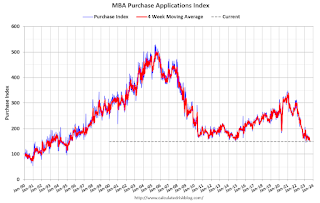 Click on graph for larger image.
Click on graph for larger image.The first graph shows the MBA mortgage purchase index.
According to the MBA, purchase activity is down 26% year-over-year unadjusted.
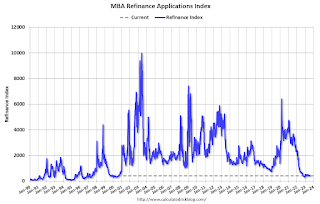
Tuesday, August 15, 2023
Wednesday: Housing Starts, Industrial Production, FOMC Minutes
by Calculated Risk on 8/15/2023 08:21:00 PM
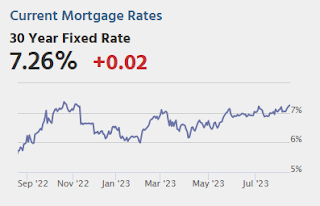
Wednesday:
• At 7:00 AM ET, The Mortgage Bankers Association (MBA) will release the results for the mortgage purchase applications index.
• At 8:30 AM, Housing Starts for July. The consensus is for 1.440 million SAAR, up from 1.434 million SAAR in June.
• At 9:15 AM, The Fed will release Industrial Production and Capacity Utilization for July. The consensus is for a 0.3% increase in Industrial Production, and for Capacity Utilization to increase to 79.2%.
• At 2:00 PM, FOMC Minutes, Meeting of July 25-26, 2023
The "New Normal" Mortgage Rate Range
by Calculated Risk on 8/15/2023 03:15:00 PM
Today, in the Calculated Risk Real Estate Newsletter: The "New Normal" Mortgage Rate Range
A brief excerpt:
In early June, I wrote: Could 6% to 7% 30-Year Mortgage Rates be the "New Normal"? This is an update to that post with some additional research.There is much more in the article. You can subscribe at https://calculatedrisk.substack.com/
In the previous post I noted that a key pitch, by real estate agents for home buyers right now, is that they will likely be able to refinance at a lower mortgage rate in a few years. The argument is that once the Federal Reserve has inflation back down to the 2% target, 30-mortgage rates will decline, perhaps to around 5% or lower. Of course, no one expects to see 3% mortgage rates without another crisis.
This graph is from Mortgage News Daily and shows the 30-year mortgage rate since 2010. Rates were mostly in the 3.5% to 5% range for over a decade prior to the pandemic. Currently rates are at 7.26% for 30-year mortgage rates.
NAHB: Builder Confidence Decreased in August "on Rising Mortgage Rates"
by Calculated Risk on 8/15/2023 10:05:00 AM
The National Association of Home Builders (NAHB) reported the housing market index (HMI) was at 50, down from 56 last month. Any number above 50 indicates that more builders view sales conditions as good than poor.
From the NAHB: Builder Confidence Falls on Rising Mortgage Rates
After steadily rising for seven consecutive months, builder confidence retreated in August as rising mortgage rates nearing 7% (per Freddie Mac) and stubbornly high shelter inflation have further eroded housing affordability and put a damper on consumer demand.
Builder confidence in the market for newly built single-family homes in August fell six points to 50, according to the National Association of Home Builders (NAHB)/Wells Fargo Housing Market Index (HMI) released today.
“Rising mortgage rates and high construction costs stemming from a dearth of construction workers, a lack of buildable lots and ongoing shortages of distribution transformers put a chill on builder sentiment in August,” said NAHB Chairman Alicia Huey, a custom home builder and developer from Birmingham, Ala. “But while this latest confidence reading is a reminder that housing affordability is an ongoing challenge, demand for new construction continues to be supported by a lack of resale inventory, as many home owners elect to stay put because they are locked in at a low mortgage rate.”
...
The August HMI survey also revealed that rising mortgage rates are causing more builders to use sales incentives to attract home buyers. After dropping steadily for four months (from 31% in March to 22% in July), the share of builders cutting prices to bolster sales rose again to 25% in August. The average decline for builders reducing prices remained at 6%. And the share of builders using incentives to bolster sales was 55% in August, higher than in July (52%) but still lower than in December 2022 (62%).
Derived from a monthly survey that NAHB has been conducting for more than 35 years, the NAHB/Wells Fargo HMI gauges builder perceptions of current single-family home sales and sales expectations for the next six months as “good,” “fair” or “poor.” The survey also asks builders to rate traffic of prospective buyers as “high to very high,” “average” or “low to very low.” Scores for each component are then used to calculate a seasonally adjusted index where any number over 50 indicates that more builders view conditions as good than poor.
All three major HMI indices posted declines in August. The HMI index gauging current sales conditions fell five points to 57, the component charting sales expectations in the next six months declined four points to 55 and the gauge measuring traffic of prospective buyers dropped six points to 34.
Looking at the three-month moving averages for regional HMI scores, the Northeast increased four points to 56, the Midwest and South were both unchanged at 45 and 58, respectively, and the West edged down a single point to 50.
emphasis added
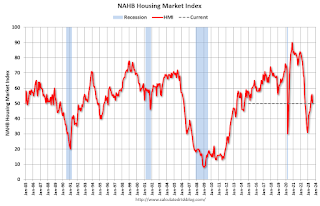 Click on graph for larger image.
Click on graph for larger image.This graph shows the NAHB index since Jan 1985.
This was below the consensus forecast.
Retail Sales Increased 0.7% in July
by Calculated Risk on 8/15/2023 08:37:00 AM
On a monthly basis, retail sales were up 0.7% from June to July (seasonally adjusted), and sales were up 3.2 percent from June 2022.
From the Census Bureau report:
Advance estimates of U.S. retail and food services sales for July 2023, adjusted for seasonal variation and holiday and trading-day differences, but not for price changes, were $696.4 billion, up 0.7 percent from the previous month, and up 3.2 percent above July 2022. ... The May 2023 to June 2023 percent change was revised from up 0.2 percent to up 0.3 percent.
emphasis added
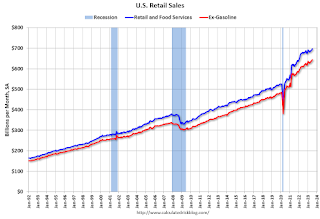 Click on graph for larger image.
Click on graph for larger image.This graph shows retail sales since 1992. This is monthly retail sales and food service, seasonally adjusted (total and ex-gasoline).
Retail sales ex-gasoline were up 0.8% in July.
The second graph shows the year-over-year change in retail sales and food service (ex-gasoline) since 1993.
Retail and Food service sales, ex-gasoline, increased by 5.6% on a YoY basis.
 The increase in sales in July was well above expectations, and sales in May and June were revised up.
The increase in sales in July was well above expectations, and sales in May and June were revised up.
Monday, August 14, 2023
Tuesday: Retail Sales, NY Fed Mfg, Homebuilder Survey
by Calculated Risk on 8/14/2023 09:02:00 PM
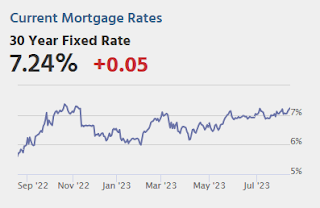
As of today, it's official. The average lender is quoting top tier 30yr fixed scenarios at the highest rates since November 7th. [30 year fixed 7.24%]Tuesday:
emphasis added
• At 8:30 AM ET, Retail sales for July is scheduled to be released. The consensus is for 0.4% increase in retail sales.
• Also at 8:30 AM, The New York Fed Empire State manufacturing survey for August. The consensus is for a reading of -0.7, down from 1.1.
• At 10:00 AM, The August NAHB homebuilder survey. The consensus is for a reading of 56, unchanged from 56. Any number above 50 indicates that more builders view sales conditions as good than poor.
Part 2: Current State of the Housing Market; Overview for mid-August
by Calculated Risk on 8/14/2023 03:52:00 PM
Today, in the Calculated Risk Real Estate Newsletter: Part 2: Current State of the Housing Market; Overview for mid-August
A brief excerpt:
On Friday, in Part 1: Current State of the Housing Market; Overview for mid-August I reviewed home inventory and sales.There is much more in the article. You can subscribe at https://calculatedrisk.substack.com/
...
Most measures of house prices have shown an increase in prices over the last several months, and a key question is Will house prices decline further later this year?
Other measures of house prices suggest prices will be up YoY soon in the Case-Shiller index. The NAR reported median prices were down 0.9% YoY in June, smaller than the 3.0% YoY decline in May. Black Knight reported prices were up 0.8% YoY in June to new all-time highs, and Freddie Mac reported house prices were up 1.7% YoY in June, up from 0.8% in May.
Here is a comparison of year-over-year change in the FMHPI, median house prices from the NAR, and the Case-Shiller National index.
The FMHPI and the NAR median prices appear to be leading indicators for Case-Shiller. Based on recent monthly data, and the FMHPI, it seems likely the YoY change in the Case-Shiller index will turn positive this summer.


